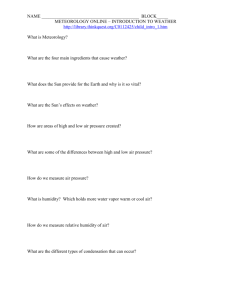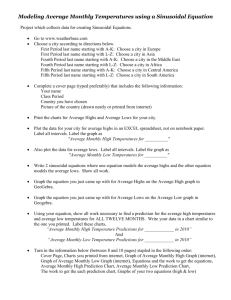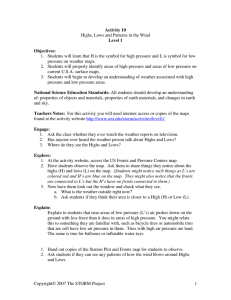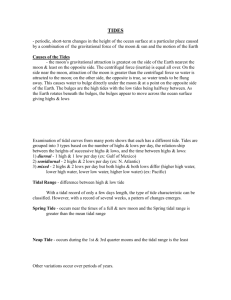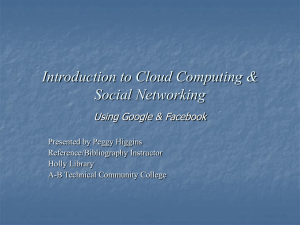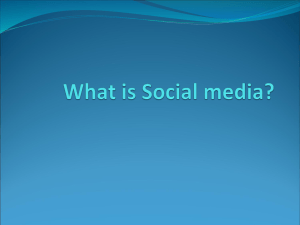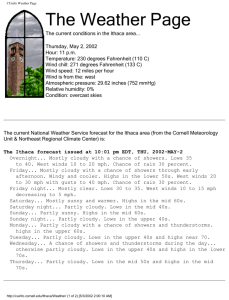File
advertisement
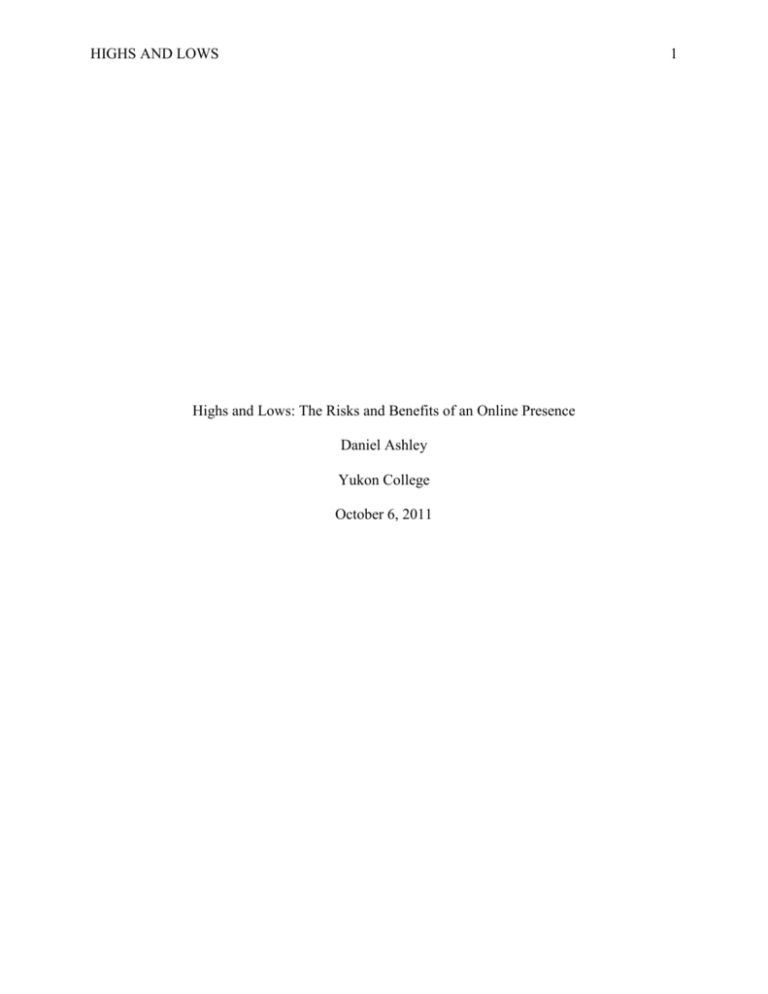
HIGHS AND LOWS 1 Highs and Lows: The Risks and Benefits of an Online Presence Daniel Ashley Yukon College October 6, 2011 HIGHS AND LOWS 2 Highs and Lows: The Risks and Benefits of an Online Presence There are risks and benefits to maintaining an online presence. Currently some kind of online presence is almost unavoidable for most people. Most newspapers and press releases are published online in digital format. This results in an online presence for anyone whose name has recently been cited in any public print. The example above is a passive component of our online presence; in many cases people are actively engaged in building and promoting their Internet profile. The use of social networking and media sites such as facebook or youtube, has changed the face of many people’s personal and professional lives. An online presence can create great social, educational, and economic advantages. Online personas also leave us more exposed to misinterpretation than ever before in history. Through text, photo, video, and sound our everyday actions can be seen and analyzed by more people than ever. It is important to be aware of the risks and benefits of maintaining an online presence and to make informed choices about the content that we present online. To have an online presence has many implications. There are many different types of services, social networks, media, and information that form a person’s online presence. The most basic and readily accessible way to assess the size of someone’s presence on the Internet is the good “old fashioned” Google search. Simply type a name into the Google search engine and have a look at the results. Usually what is found is a random smattering of information including anything written about that person in a magazine or newspaper, photos published or uploaded to websites, and their address and phone number in the white pages. It could also include videos that have been tagged with the person’s name on Youtube, or links to their profile on social networking sites such as Facebook or Twitter. These are just a few examples of the types of personal information found by a Google search. An online presence may also include a personal HIGHS AND LOWS 3 profile on a social networking site such as Facebook or Twitter. These are currently two of the most popular social networking sites however there are countless others; these sites gain, and lose popularity over time. A social networking site commonly contains information about a person’s interests, online groups of friends, photos, games, and applications that allow e-mail, and chat functions between members of the network. Some information on social networks can be publicly viewed by anyone on the Internet; some of it is available to network users or “friends” selected by each individual. The size of a person’s online presence in the social networking community is usually measured by how many contacts or “friends” they have, and how current the material on their profile is. Personal websites and blogs are also very common components of an online persona. The blog is usually a form of personalized website that features postings about a person’s activities and interests on a regular basis. Websites take many incarnations depending on their design and purpose. If you’re in a band you may have a page about you on the band’s promotional website. If you work for a company there may be a profile and your contact information in the company’s website directory. The examples above are the tip of the digital iceberg when it comes to the applications and vehicles that make up an individual’s online presence. The great accessibility of information and diverse media contained in a person’s online persona comes with the risk of exposure. There are risks involved in creating and maintaining an online presence. In his essay “ Google Never Forgets: A Cautionary Tale”, Max Fawcett (2012) discusses the negative impact personal content can have online: The cost of my “bad Google” has been limited to embarrassment, but for others the price of leaving a digital footprint can be much higher. Employers now routinely Google prospective hires, and one ill-considered comment on a weblog HIGHS AND LOWS 4 five years ago can mean the difference between making the final round of interviews and being passed over….(p.335) Fawcett focuses on the fact that personal information online can give employers a view of aspects of a person’s life that may have nothing to do with their work but can still reflect negatively their character. This can potentially cost someone a job or other professional opportunities (p.335). The reality of the risks related to personal information exposure online is now setting in for everyone regardless of profession, age, or personal occupation. The potential exposure of the Internet can be dangerous because it supports many forms of media including text, photos, and audio. Posting photos online may be one of the riskier activities, particularly since the advent of “tagging” a social networking function allowing you to post names to pictures of people. This is in part because photos can be viewed completely out of context from their original setting. That blurry picture of you dancing on a table at a bachelor party can now cost you your job or keep you from getting one in the first place. A potential employer doesn’t necessarily know that you’re a straight edge guy or gal 364 days a year if he finds that one negative photo or on Facebook. The same risks are equally present with video on websites such as Youtube. The accessibility of portable video cameras built into cell phones and other electronic devices now means that there are eyes everywhere. Never before has it been so easy to record or be recorded with or with the consent of the person on camera. This comes with the possibility of any action we take in public being recorded, and posted online. The reality may make people more guarded in their public interactions and activities. Despite the risks, the number of people with some form of online presence is growing exponentially for a number of reasons. In the digital age creating and maintaining an online presence has definite social, professional, and educational advantages. One of the most obvious HIGHS AND LOWS 5 advantages of an online presence is the ability to network with a vast number of people from around the globe. Chatting with your buddy in Korea is now just as easy as visiting your Grandma down the street. The ease and affordability of communicating through text, voice, and video via the Internet has broken down geographical boundaries in a way never before possible. The advent of social networks such as Facebook has completely revolutionized the world of personal and professional networking. People from diverse backgrounds and locations can share ideas through a variety of media. It also allows groups of people with similar interests to find each other online. In the past making personal connections was limited to social groups directly accessible to people. Currently there are potentially limitless numbers of connections that can be made across the Internet and social networks. The social revolution on the Internet has huge value in breaking down cultural barriers between individuals and nations. Online personas and social networks have rapidly become a valuable tool for working professionals in many fields. An architect or music producer can now display their portfolio online in a variety of formats. Social networks can then be used to promote their online content to other professionals in their field. This form of promotion and advertising has become extremely valuable. Part of the reason is that it is a decentralized model of content distribution. An online presence also allows a professional to present work in progress and receive feedback from a huge base of people. This leads to more collaborative projects and innovations in many areas. The online presence has also shown many benefits for education. It is now standard at many universities for all students to be given a student profile when they enroll in classes. Through these profiles students can access class resources posted by professors, transcripts, and even other students who are in their classes. This is leading to the education process becoming more collaborative and accessible. Students HIGHS AND LOWS 6 can access online course resources from any computer with the Internet and work with other students in their classes from a distance to better understand course material. One of the concerns with maintaining an online presence is that personal information can be viewed by a large number of people without your knowledge or control. Many of the major online networks and service providers are continually working on ways to give each individual better and more customized privacy protection. In the article “Who Can See This?” Hartley (2011) outlines some of the key changes Facebook is making: The changes to Facebook's privacy settings include: inline profile controls that allow users to determine who will see a post via a drop down menu and a tag review feature allowing users to accept or decline a tag in a post or photo. As well when a post is visible to the entire Internet it will be labelled "public." Changes such as these are a step in the right direction for enhancing the benefits of maintaining an online persona while minimizing the risks. Features such as those outlined above operate around the idea that everyone is responsible for the content they put online and specifying who can view it. Network service providers have the obligation to make privacy controls informative, easy to use, and effective, but it still falls to each individual user to use their judgment about what they present as a part of their online presence. Not long ago the idea of an online presence was in the realm of science fiction. Today it is a reality and rapidly becoming a necessity for many people. The ease of access to our personal and professional lives through the Internet leaves us more exposed than ever. However with this exposure comes the freedom and ability to interact and exchange ideas with a vast number of people. Each individual must be mindful of the risks and benefits associated with information or HIGHS AND LOWS media included in their online presence. If service providers and online users work together to maintain privacy and integrity benefits can be maximized and risks can be minimized. 7 HIGHS AND LOWS 8 References Fawcett, M. (2012). Google never forgets: a cautionary tale. In S. Norton & N. Walsman (Eds.), Canadian content (7th ed.), (pp.333-336). Toronto, ON: Nelson. Hartley, M. (2011). Who can see this? facebook overhauls privacy settings. Canada, Don Mills, ON.: Southam Publications Inc. Retrieved from: http://search.proquest.com/docview/885454571?accountid=29144
